IPCC AR5 Chapter 9 (selected figures)
Overview
The goal of this recipe is to collect diagnostics to reproduce Chapter 9 of AR5, so that the plots can be readily reproduced and compared to previous CMIP versions. In this way we can next time start with what was available in the previous round and can focus on developing more innovative methods of analysis rather than constantly having to “re-invent the wheel”.
The plots are produced collecting the diagnostics from individual recipes. The following figures from Flato et al. (2013) can currently be reproduced:
Figure 9.2 a,b,c: Annual-mean surface air temperature for the period 1980-2005. a) multi-model mean, b) bias as the difference between the CMIP5 multi-model mean and the climatology from ERA-Interim (Dee et al., 2011), c) mean absolute model error with respect to the climatology from ERA-Interim.
Figure 9.3: Seasonality (December-January-February minus June-July-August) of surface (2 m) air temperature (°C) for the period 1980-2005. (a) Multi-model mean for the historical experiment. (b) Multi-model mean of absolute seasonality. (c) Difference between the multi-model mean and the ERA-Interim reanalysis seasonality. (d) Difference between the multi-model mean and the ERA-Interim absolute seasonality.
Figure 9.4: Annual-mean precipitation rate (mm day-1) for the period 1980-2005. a) multi-model mean, b) bias as the difference between the CMIP5 multi-model mean and the climatology from the Global Precipitation Climatology Project (Adler et al., 2003), c) multi-model mean absolute error with respect to observations, and d) multi-model mean error relative to the multi-model mean precipitation ifself.
Figure 9.5: Climatological (1985-2005) annual-mean cloud radiative effects in Wm-2 for the CMIP5 models against CERES EBAF (2001-2011) in Wm-2. Top row shows the shortwave effect; middle row the longwave effect, and bottom row the net effect. Multi-model-mean biases against CERES EBAF 2.6 are shown on the left, whereas the right panels show zonal averages from CERES EBAF 2.6 (black), the individual CMIP5 models (thin gray lines), and the multi-model mean (thick red line).
Figure 9.6: Centred pattern correlations between models and observations for the annual mean climatology over the period 1980–1999. Results are shown for individual CMIP3 (black) and CMIP5 (blue) models as thin dashes, along with the corresponding ensemble average (thick dash) and median (open circle). The four variables shown are surface air temperature (TAS), top of the atmosphere (TOA) outgoing longwave radiation (RLUT), precipitation (PR) and TOA shortwave cloud radiative effect (SW CRE). The correlations between the reference and alternate observations are also shown (solid green circles).
Figure 9.8: Observed and simulated time series of the anomalies in annual and global mean surface temperature. All anomalies are differences from the 1961-1990 time-mean of each individual time series. The reference period 1961-1990 is indicated by yellow shading; vertical dashed grey lines represent times of major volcanic eruptions. Single simulations for CMIP5 models (thin lines); multi-model mean (thick red line); different observations (thick black lines). Dataset pre-processing like described in Jones et al., 2013.
Figure 9.14: Sea surface temperature plots for zonal mean error, equatorial (5 deg north to 5 deg south) mean error, and multi model mean for zonal error and equatorial mean.
Figure 9.24: Time series of (a) Arctic and (b) Antarctic sea ice extent; trend distributions of (c) September Arctic and (d) February Antarctic sea ice extent.
Figure 9.26: Ensemble-mean global ocean carbon uptake (a) and global land carbon uptake (b) in the CMIP5 ESMs for the historical period 1900–2005. For comparison, the observation-based estimates provided by the Global Carbon Project (GCP) are also shown (thick black line). The confidence limits on the ensemble mean are derived by assuming that the CMIP5 models are drawn from a t-distribution. The grey areas show the range of annual mean fluxes simulated across the model ensemble. This figure includes results from all CMIP5 models that reported land CO2 fluxes, ocean CO2 fluxes, or both (Anav et al., 2013).
Figure 9.27: Simulation of global mean (a) atmosphere–ocean CO2 fluxes (“fgCO2”) and (b) net atmosphere–land CO2 fluxes (“NBP”), by ESMs for the period 1986–2005. For comparison, the observation-based estimates provided by Global Carbon Project (GCP) and the Japanese Meteorological Agency (JMA) atmospheric inversion are also shown. The error bars for the ESMs and observations represent interannual variability in the fluxes, calculated as the standard deviation of the annual means over the period 1986–2005.
Figure 9.42a: Equilibrium climate sensitivity (ECS) against the global mean surface air temperature, both for the period 1961-1990 and for the pre-industrial control runs.
Figure 9.42b: Transient climate response (TCR) against equilibrium climate sensitivity (ECS).
Figure 9.45a: Scatterplot of springtime snow-albedo effect values in climate change vs. springtime d(alphas)/d(Ts) values in the seasonal cycle in transient climate change experiments (Hall and Qu, 2006).
Available recipes and diagnostics
Recipes are stored in esmvaltool/recipes/
recipe_flato13ipcc.yml
Diagnostics are stored in esmvaltool/diag_scripts/
carbon_cycle/main.ncl: See here.
climate_metrics/ecs.py: See here.
clouds/clouds_bias.ncl: global maps of the multi-model mean and the multi-model mean bias (Fig. 9.2, 9.4)
clouds/clouds_isccp: global maps of multi-model mean minus observations + zonal averages of individual models, multi-model mean and observations (Fig. 9.5)
ipcc_ar5/ch09_fig09_3.ncl: multi-model mean seasonality of near-surface temperature (Fig. 9.3)
ipcc_ar5/ch09_fig09_6.ncl: calculating pattern correlations of annual mean climatologies for one variable (Fig 9.6 preprocessing)
ipcc_ar5/ch09_fig09_6_collect.ncl: collecting pattern correlation for each variable and plotting correlation plot (Fig 9.6)
ipcc_ar5/tsline.ncl: time series of the global mean (anomaly) (Fig. 9.8)
ipcc_ar5/ch09_fig09_14.py: Zonally averaged and equatorial SST (Fig. 9.14)
seaice/seaice_tsline.ncl: Time series of sea ice extent (Fig. 9.24a/b)
seaice/seaice_trends.ncl: Trend distributions of sea ice extent (Fig 9.24c/d)
ipcc_ar5/ch09_fig09_42a.py: ECS vs. surface air temperature (Fig. 9.42a)
ipcc_ar5/ch09_fig09_42b.py: TCR vs. ECS (Fig. 9.42b)
emergent_constraints/snowalbedo.ncl: snow-albedo effect (Fig. 9.45a)
User settings in recipe
Script carbon_cycle/main.ncl
See here.
Script climate_metrics/ecs.py
See here.
Script clouds/clouds_bias.ncl
Script clouds_bias.ncl
Required settings (scripts)
none
Optional settings (scripts)
plot_abs_diff: additionally also plot absolute differences (true, false)
plot_rel_diff: additionally also plot relative differences (true, false)
projection: map projection, e.g., Mollweide, Mercator
timemean: time averaging, i.e. “seasonalclim” (DJF, MAM, JJA, SON), “annualclim” (annual mean)
Required settings (variables)*
reference_dataset: name of reference datatset
Optional settings (variables)
long_name: description of variable
Color tables
variable “tas”: diag_scripts/shared/plot/rgb/ipcc-tas.rgb, diag_scripts/shared/plot/rgb/ipcc-tas-delta.rgb
variable “pr-mmday”: diag_scripts/shared/plots/rgb/ipcc-precip.rgb, diag_scripts/shared/plot/rgb/ipcc-precip-delta.rgb
Script clouds/clouds_ipcc.ncl
Required settings (scripts)
none
Optional settings (scripts)
explicit_cn_levels: contour levels
mask_ts_sea_ice: true = mask T < 272 K as sea ice (only for variable “ts”); false = no additional grid cells masked for variable “ts”
projection: map projection, e.g., Mollweide, Mercator
styleset: style set for zonal mean plot (“CMIP5”, “DEFAULT”)
timemean: time averaging, i.e. “seasonalclim” (DJF, MAM, JJA, SON), “annualclim” (annual mean)
valid_fraction: used for creating sea ice mask (mask_ts_sea_ice = true): fraction of valid time steps required to mask grid cell as valid data
Required settings (variables)
reference_dataset: name of reference data set
Optional settings (variables)
long_name: description of variable
units: variable units
Color tables
variables “pr”, “pr-mmday”: diag_scripts/shared/plot/rgb/ipcc-precip-delta.rgb
Script ipcc_ar5/tsline.ncl
Required settings for script
styleset: as in diag_scripts/shared/plot/style.ncl functions
Optional settings for script
time_avg: type of time average (currently only “yearly” and “monthly” are available).
ts_anomaly: calculates anomalies with respect to the defined period; for each gird point by removing the mean for the given calendar month (requiring at least 50% of the data to be non-missing)
ref_start: start year of reference period for anomalies
ref_end: end year of reference period for anomalies
ref_value: if true, right panel with mean values is attached
ref_mask: if true, model fields will be masked by reference fields
region: name of domain
plot_units: variable unit for plotting
y-min: set min of y-axis
y-max: set max of y-axis
mean_nh_sh: if true, calculate first NH and SH mean
volcanoes: if true, lines of main volcanic eruptions will be added
run_ave: if not equal 0 than calculate running mean over this number of years
header: if true, region name as header
Required settings for variables
none
Optional settings for variables
reference_dataset: reference dataset; REQUIRED when calculating anomalies
Color tables
e.g. diag_scripts/shared/plot/styles/cmip5.style
Script ipcc_ar5/ch09_fig09_3.ncl
Required settings for script
none
Optional settings for script
projection: map projection, e.g., Mollweide, Mercator (default = Robinson)
Required settings for variables
reference_dataset: name of reference observation
Optional settings for variables
map_diff_levels: explicit contour levels for plotting
Script ipcc_ar5/ch09_fig09_6.ncl
Required settings for variables
reference_dataset: name of reference observation
Optional settings for variables
alternative_dataset: name of alternative observations
Script ipcc_ar5/ch09_fig09_6_collect.ncl
Required settings for script
none
Optional settings for script
diag_order: List of diagnostic names in the order variables should appear on x-axis
Script seaice/seaice_trends.ncl
Required settings (scripts)
month: selected month (1, 2, …, 12) or annual mean (“A”)
region: region to be analyzed ( “Arctic” or “Antarctic”)
Optional settings (scripts)
fill_pole_hole: fill observational hole at North pole, Default: False
Optional settings (variables)
ref_model: array of references plotted as vertical lines
Script seaice/seaice_tsline.ncl
Required settings (scripts)
region: Arctic, Antarctic
month: annual mean (A), or month number (3 = March, for Antarctic; 9 = September for Arctic)
Optional settings (scripts)
styleset: for plot_type cycle only (cmip5, cmip6, default)
multi_model_mean: plot multi-model mean and standard deviation (default: False)
EMs_in_lg: create a legend label for individual ensemble members (default: False)
fill_pole_hole: fill polar hole (typically in satellite data) with sic = 1 (default: False)
Script ipcc_ar5/ch09_fig09_42a.py
Required settings for script
none
Optional settings for script
axes_functions:
dictcontaining methods executed for the plot’smatplotlib.axes.Axesobject.dataset_style: name of the style file (located in
esmvaltool.diag_scripts.shared.plot.styles_python).matplotlib_style: name of the matplotlib style file (located in
esmvaltool.diag_scripts.shared.plot.styles_python.matplotlib).save:
dictcontaining keyword arguments for the functionmatplotlib.pyplot.savefig().seaborn_settings: Options for
seaborn.set()(affects all plots).
Script ipcc_ar5/ch09_fig09_42b.py
Required settings for script
none
Optional settings for script
dataset_style: Dataset style file (located in
esmvaltool.diag_scripts.shared.plot.styles_python). The entrymarkeris ignored whenmarker_fileis given.log_x: Apply logarithm to X axis (ECS).
log_y: Apply logarithm to Y axis (TCR).
marker_column: Name of the column to look up markers in
marker_file.marker_file: CSV file with markers (can also be integers). Must have the columns
datasetandmarker(or the column specified bymarker_column). If a relative path is given, assumes that this is a pattern to search for ancestor files.savefig_kwargs: Keyword arguments for
matplotlib.pyplot.savefig().seaborn_settings: Options for
seaborn.set()(affects all plots).x_lim: Plot limits for X axis (ECS).
y_lim: Plot limits for Y axis (TCR).
Script emergent_constraints/snowalbedo.ncl
Required settings for script
exp_presentday: name of present-day experiment (e.g. “historical”)
exp_future: name of climate change experiment (e.g. “rcp45”)
Optional settings for script
diagminmax: observational uncertainty (min and max)
legend_outside: create extra file with legend (true, false)
styleset: e.g. “CMIP5” (if not set, this diagnostic will create its own color table and symbols for plotting)
suffix: string to be added to output filenames
xmax: upper limit of x-axis (default = automatic)
xmin: lower limit of x-axis (default = automatic)
ymax: upper limit of y-axis (default = automatic)
ymin: lower limit of y-axis (default = automatic)
Required settings for variables
ref_model: name of reference data set
Optional settings for variables
none
Variables
areacello (fx, longitude latitude)
fgco2 (ocean, monthly mean, longitude latitude time)
nbp (ocean, monthly mean, longitude latitude time)
pr (atmos, monthly mean, longitude latitude time)
rlut, rlutcs (atmos, monthly mean, longitude latitude time)
rsdt (atmos, monthly mean, longitude latitude time)
rsuscs, rsdscs (atmos, monthly mean, longitude latitude time)
rsut, rsutcs (atmos, monthly mean, longitude latitude time)
sic (ocean-ice, monthly mean, longitude latitude time)
tas (atmos, monthly mean, longitude latitude time)
tos (ocean, monthly mean, longitude, latitude, time)
Observations and reformat scripts
Note: (1) obs4MIPs data can be used directly without any preprocessing; (2) see headers of reformat scripts for non-obs4MIPs data for download instructions.
CERES-EBAF (rlut, rlutcs, rsut, rsutcs - obs4MIPs)
ERA-Interim (tas, ta, ua, va, zg, hus - esmvaltool/cmorizers/data/formatters/datasets/era-interim.py)
GCP2018 (fgco2, nbp - esmvaltool/cmorizers/data/formatters/datasets/gcp2018.py)
GPCP-SG (pr - obs4MIPs)
JMA-TRANSCOM (fgco2, nbp - esmvaltool/cmorizers/data/formatters/datasets/jma_transcom.py)
HadCRUT4 (tas - esmvaltool/cmorizers/data/formatters/datasets/hadcrut4.ncl)
HadISST (sic, tos - esmvaltool/cmorizers/data/formatters/datasets/hadisst.ncl)
ISCCP-FH (rsuscs, rsdscs, rsdt - esmvaltool/cmorizers/data/formatters/datasets/isccp_fh.ncl)
References
Flato, G., J. Marotzke, B. Abiodun, P. Braconnot, S.C. Chou, W. Collins, P. Cox, F. Driouech, S. Emori, V. Eyring, C. Forest, P. Gleckler, E. Guilyardi, C. Jakob, V. Kattsov, C. Reason and M. Rummukainen, 2013: Evaluation of Climate Models. In: Climate Change 2013: The Physical Science Basis. Contribution of Working Group I to the Fifth Assessment Report of the Intergovernmental Panel on Climate Change [Stocker, T.F., D. Qin, G.-K. Plattner, M. Tignor, S.K. Allen, J. Boschung, A. Nauels, Y. Xia, V. Bex and P.M. Midgley (eds.)]. Cambridge University Press, Cambridge, United Kingdom and New York, NY, USA.
Hall, A., and X. Qu, 2006: Using the current seasonal cycle to constrain snow albedo feedback in future climate change, Geophys. Res. Lett., 33, L03502, doi:10.1029/2005GL025127.
Jones et al., 2013: Attribution of observed historical near-surface temperature variations to anthropogenic and natural causes using CMIP5 simulations. Journal of Geophysical Research: Atmosphere, 118, 4001-4024, doi:10.1002/jgrd.50239.
Example plots
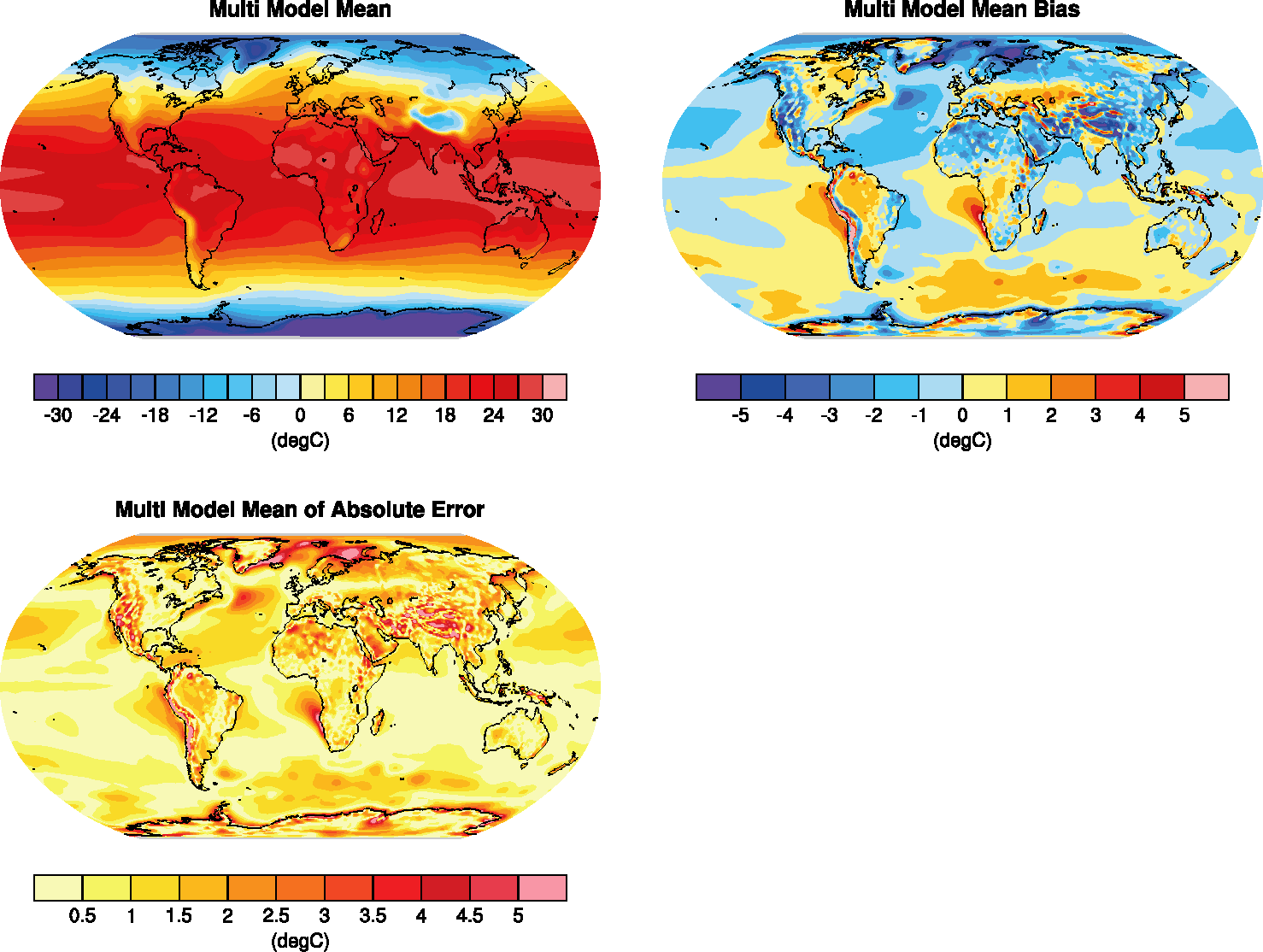
Fig. 127 Figure 9.2 a,b,c: Annual-mean surface air temperature for the period 1980-2005. a) multi-model mean, b) bias as the difference between the CMIP5 multi-model mean and the climatology from ERA-Interim (Dee et al., 2011), c) mean absolute model error with respect to the climatology from ERA-Interim.
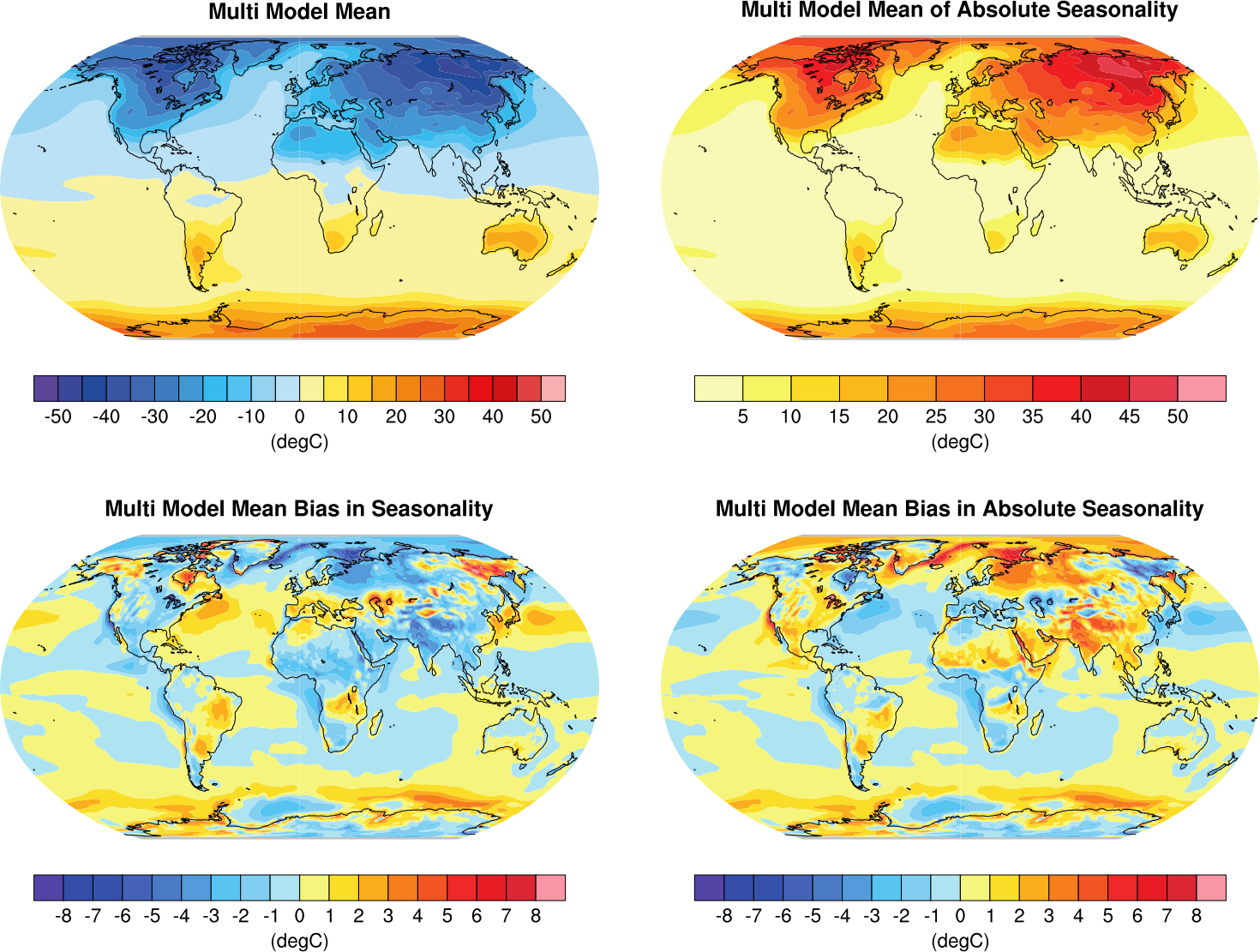
Fig. 128 Figure 9.3: Multi model values for seasonality of near-surface temperature, from top left to bottom right: mean, mean of absolute seasonality, mean bias in seasonality, mean bias in absolute seasonality. Reference dataset: ERA-Interim.
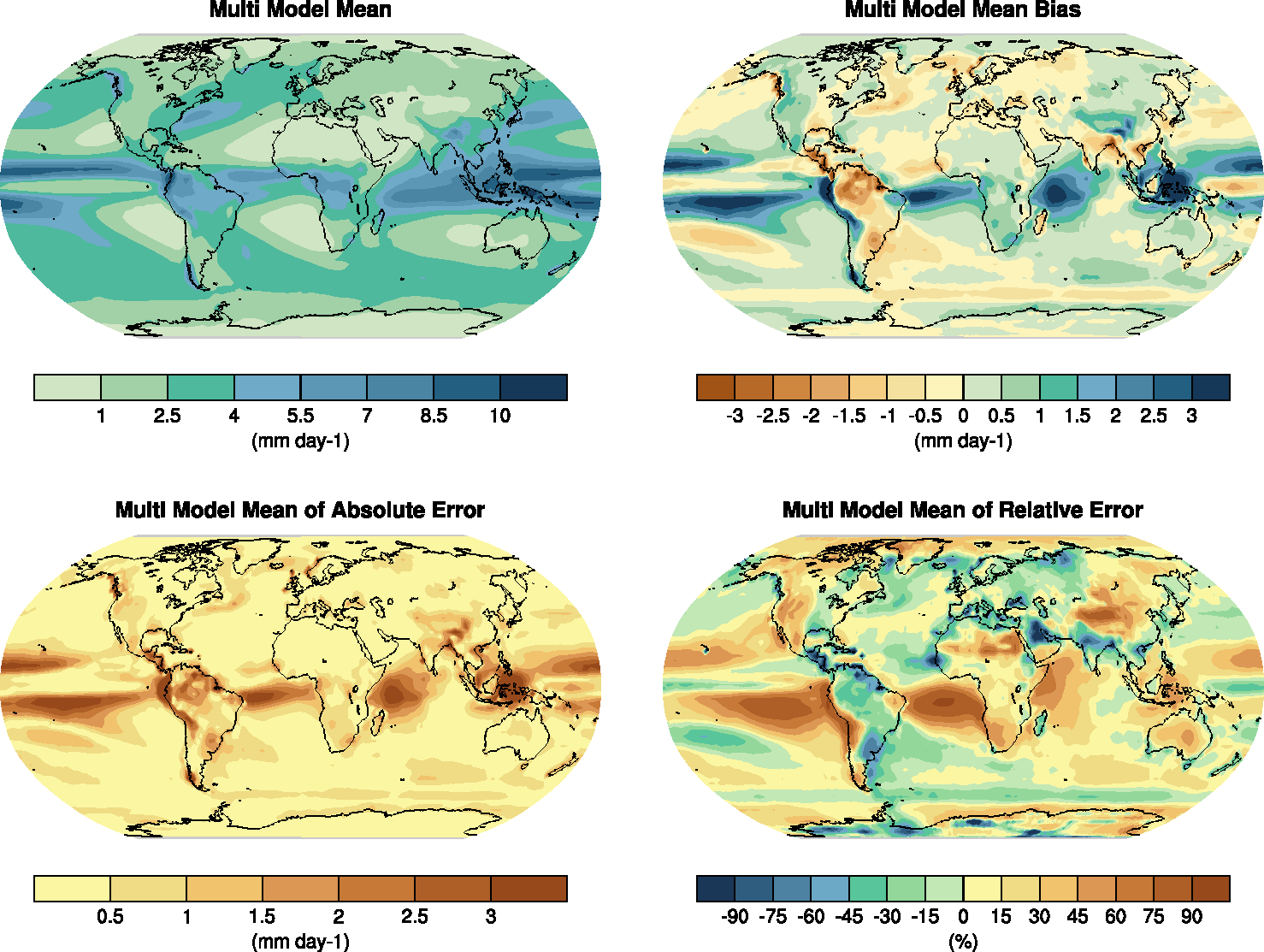
Fig. 129 Figure 9.4: Annual-mean precipitation rate (mm day-1) for the period 1980-2005. a) multi-model mean, b) bias as the difference between the CMIP5 multi-model mean and the climatology from the Global Precipitation Climatology Project (Adler et al., 2003), c) multi-model mean absolute error with respect to observations, and d) multi-model mean error relative to the multi-model mean precipitation ifself.
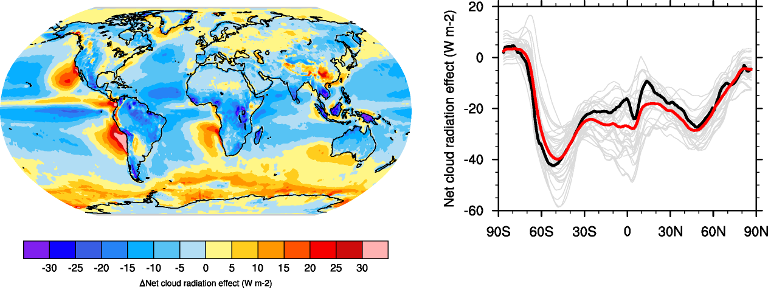
Fig. 130 Figure 9.5: Climatological (1985-2005) annual-mean cloud radiative effects in Wm-2 for the CMIP5 models against CERES EBAF (2001-2011) in Wm-2. Top row shows the shortwave effect; middle row the longwave effect, and bottom row the net effect. Multi-model-mean biases against CERES EBAF 2.6 are shown on the left, whereas the right panels show zonal averages from CERES EBAF 2.6 (black), the individual CMIP5 models (thin gray lines), and the multi-model mean (thick red line).
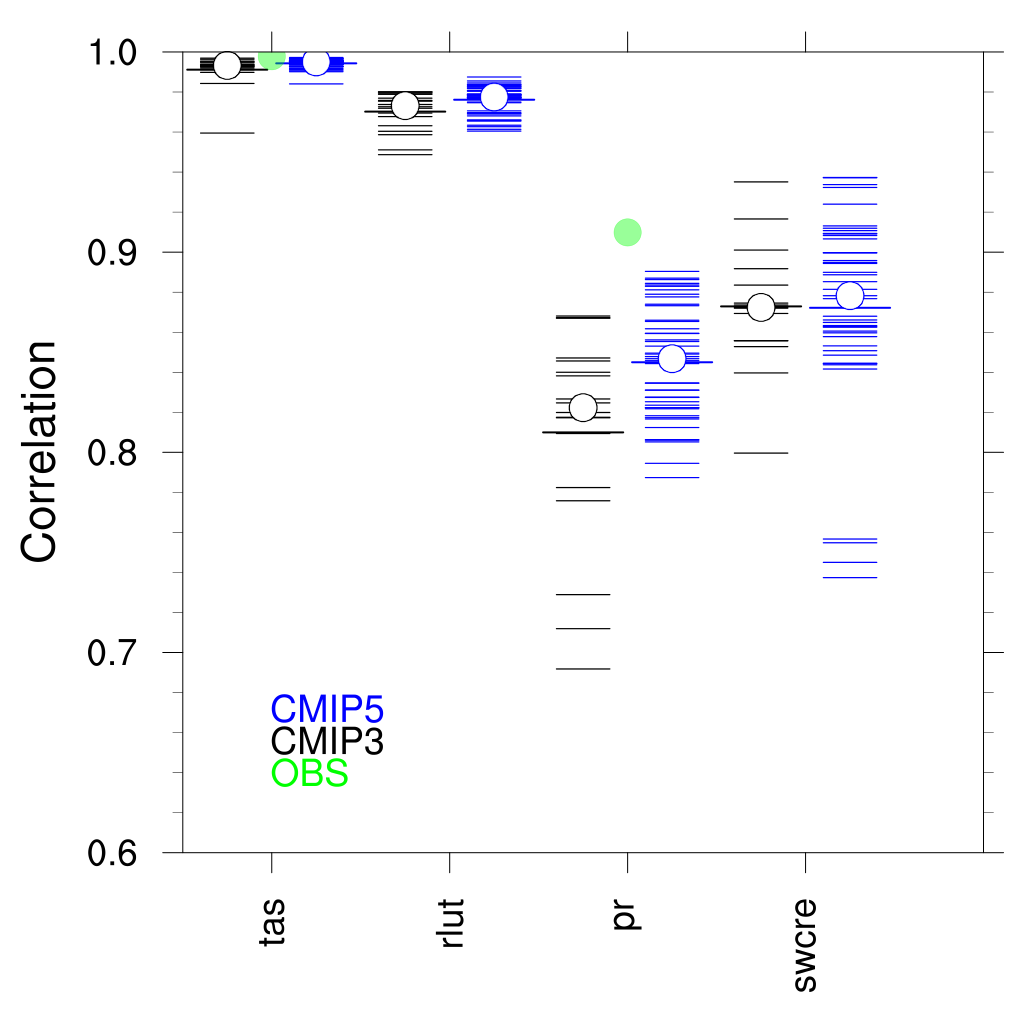
Fig. 131 Figure 9.6: Centred pattern correlations between models and observations for the annual mean climatology over the period 1980–1999. Results are shown for individual CMIP3 (black) and CMIP5 (blue) models as thin dashes, along with the corresponding ensemble average (thick dash) and median (open circle). The four variables shown are surface air temperature (TAS), top of the atmosphere (TOA) outgoing longwave radiation (RLUT), precipitation (PR) and TOA shortwave cloud radiative effect (SW CRE). The correlations between the reference and alternate observations are also shown (solid green circles).
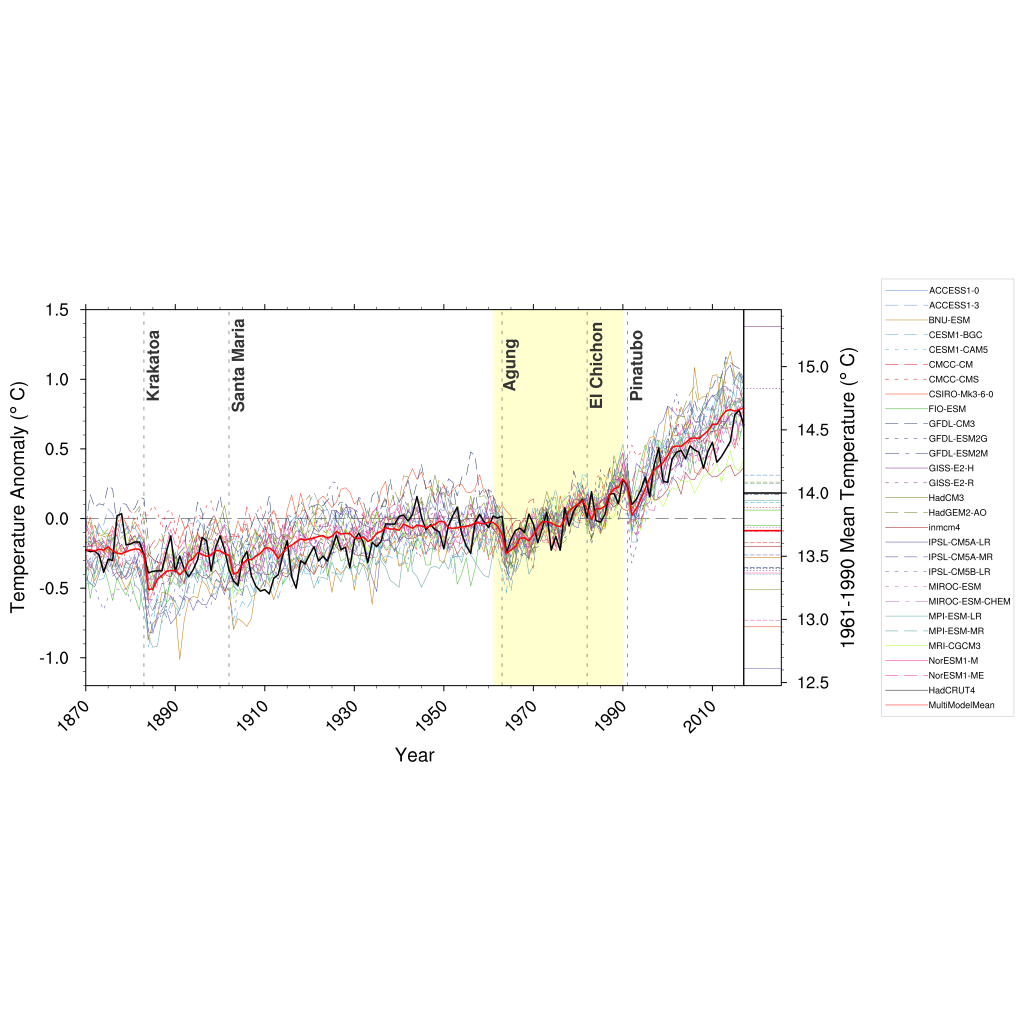
Fig. 132 Figure 9.8: Observed and simulated time series of the anomalies in annual and global mean surface temperature. All anomalies are differences from the 1961-1990 time-mean of each individual time series. The reference period 1961-1990 is indicated by yellow shading; vertical dashed grey lines represent times of major volcanic eruptions. Single simulations for CMIP5 models (thin lines); multi-model mean (thick red line); different observations (thick black lines). Dataset pre-processing like described in Jones et al., 2013.
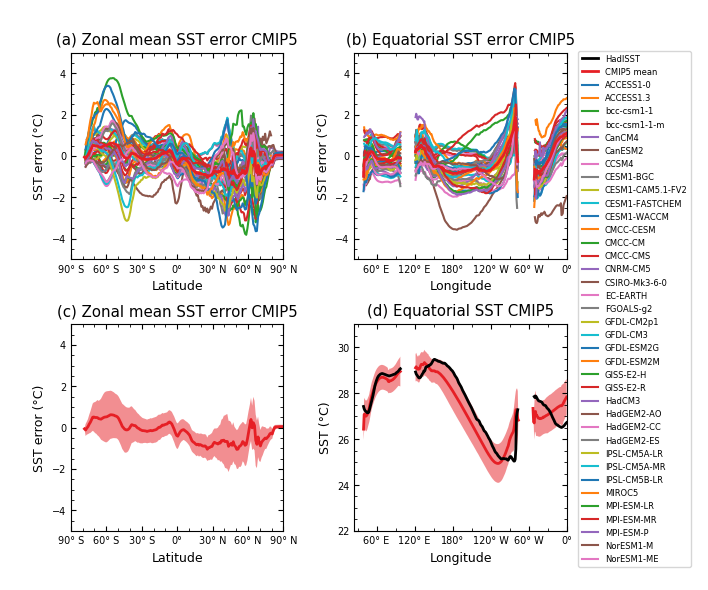
Fig. 133 Figure 9.14: (a) Zonally averaged sea surface temperature (SST) error in CMIP5 models. (b) Equatorial SST error in CMIP5 models. (c) Zonally averaged multi-model mean SST error for CMIP5 together with inter-model standard deviation (shading). (d) Equatorial multi-model mean SST in CMIP5 together with inter-model standard deviation (shading) and observations (black). Model climatologies are derived from the 1979-1999 mean of the historical simulations. The Hadley Centre Sea Ice and Sea Surface Temperature (HadISST) (Rayner et al., 2003) observational climatology for 1979-1999 is used as a reference for the error calculation (a), (b), and (c); and for observations in (d).
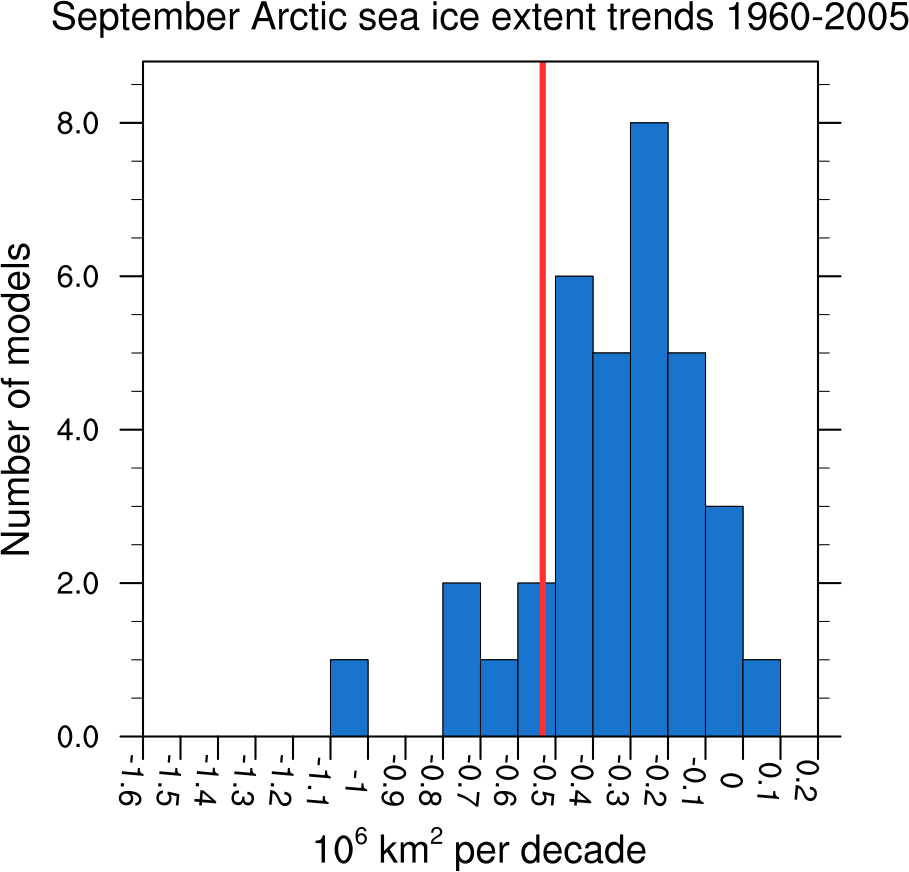
Fig. 134 Figure 9.24c: Sea ice extent trend distribution for the Arctic in September.

Fig. 135 Figure 9.24a: Time series of total sea ice area and extent (accumulated) for the Arctic in September including multi-model mean and standard deviation.
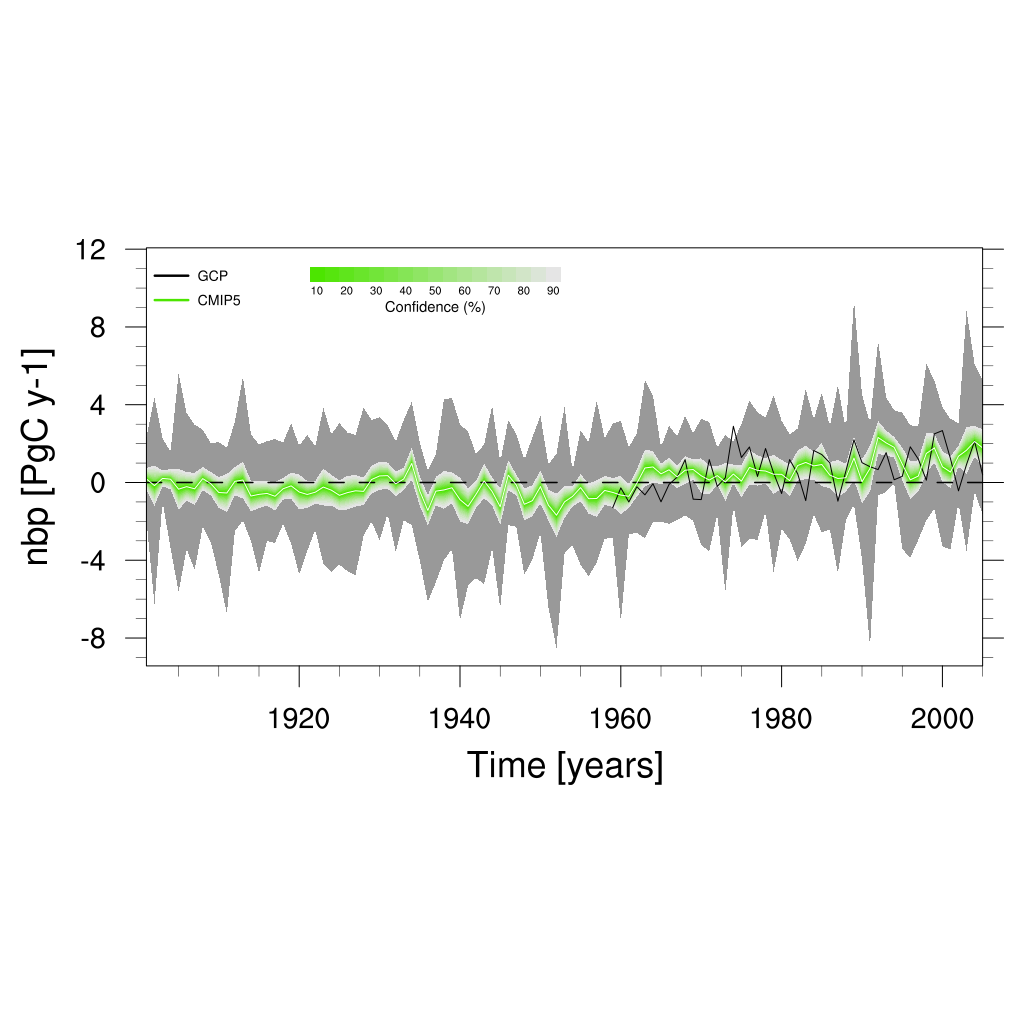
Fig. 136 Figure 9.26 (bottom): Ensemble-mean global land carbon uptake in the CMIP5 ESMs for the historical period 1900–2005. For comparison, the observation-based estimates provided by the Global Carbon Project (GCP) are also shown (black line). The confidence limits on the ensemble mean are derived by assuming that the CMIP5 models come from a t-distribution. The grey areas show the range of annual mean fluxes simulated across the model ensemble.
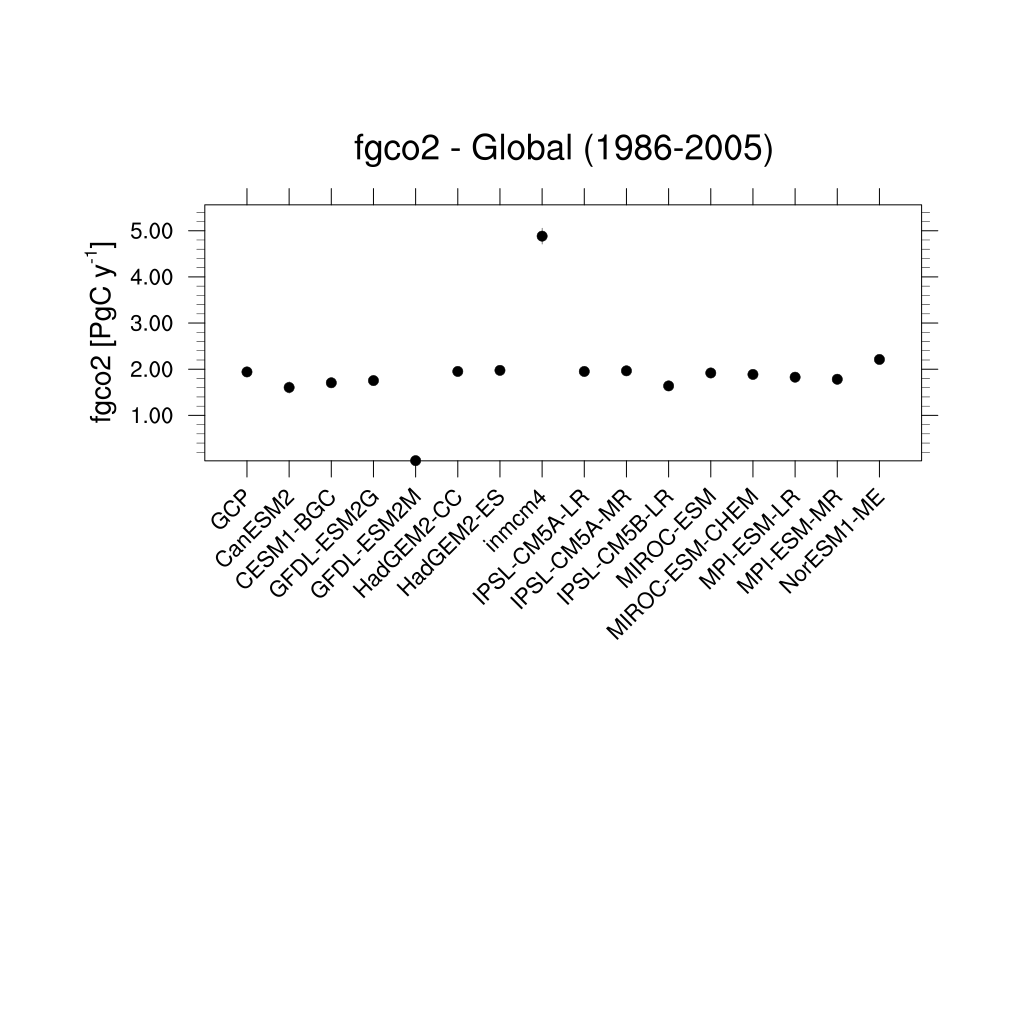
Fig. 137 Figure 9.27 (top): Simulation of global mean atmosphere–ocean CO2 fluxes (“fgCO2”) by ESMs for the period 1986–2005. For comparison, the observation-based estimates provided by Global Carbon Project (GCP) are also shown. The error bars for the ESMs and observations represent interannual variability in the fluxes, calculated as the standard deviation of the annual means over the period 1986–2005.

Fig. 138 Figure 9.42a: Equilibrium climate sensitivity (ECS) against the global mean surface air temperature of CMIP5 models, both for the period 1961-1990 (larger symbols) and for the pre-industrial control runs (smaller symbols).

Fig. 139 Figure 9.42b: Transient climate response (TCR) against equilibrium climate sensitivity (ECS) for CMIP5 models.
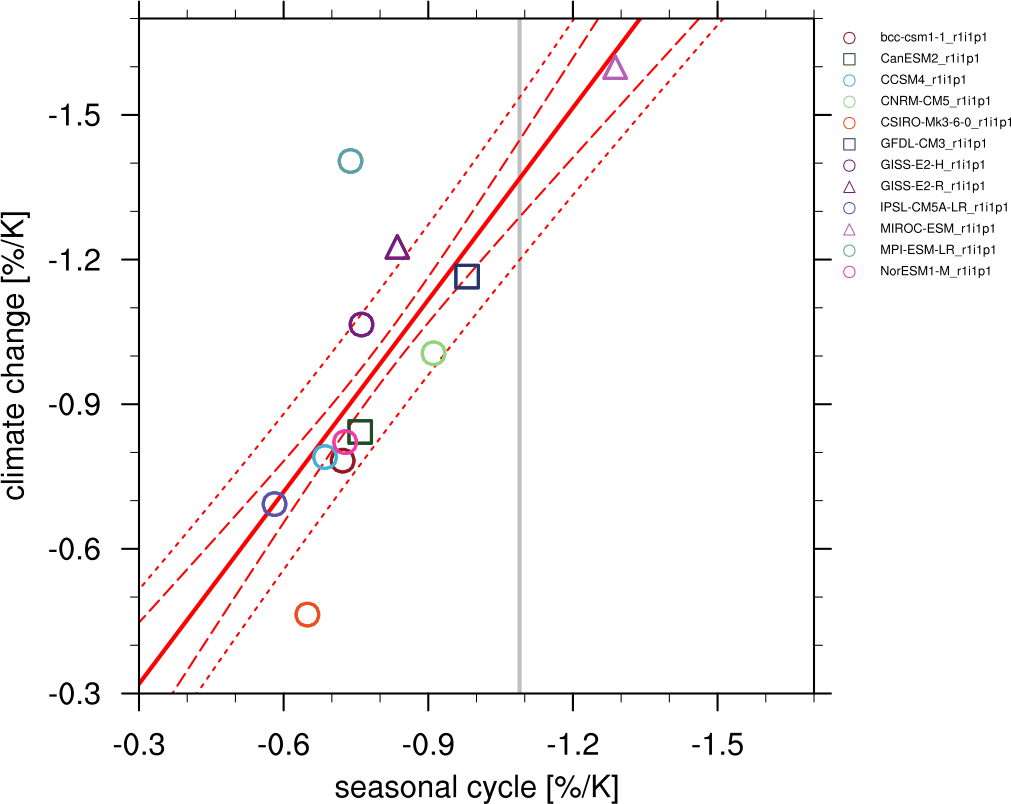
Fig. 140 Figure 9.45a: Scatterplot of springtime snow-albedo effect values in climate change vs. springtime \(\Delta \alpha_s\)/\(\Delta T_s\) values in the seasonal cycle in transient climate change experiments (CMIP5 historical experiments: 1901-2000, RCP4.5 experiments: 2101-2200).